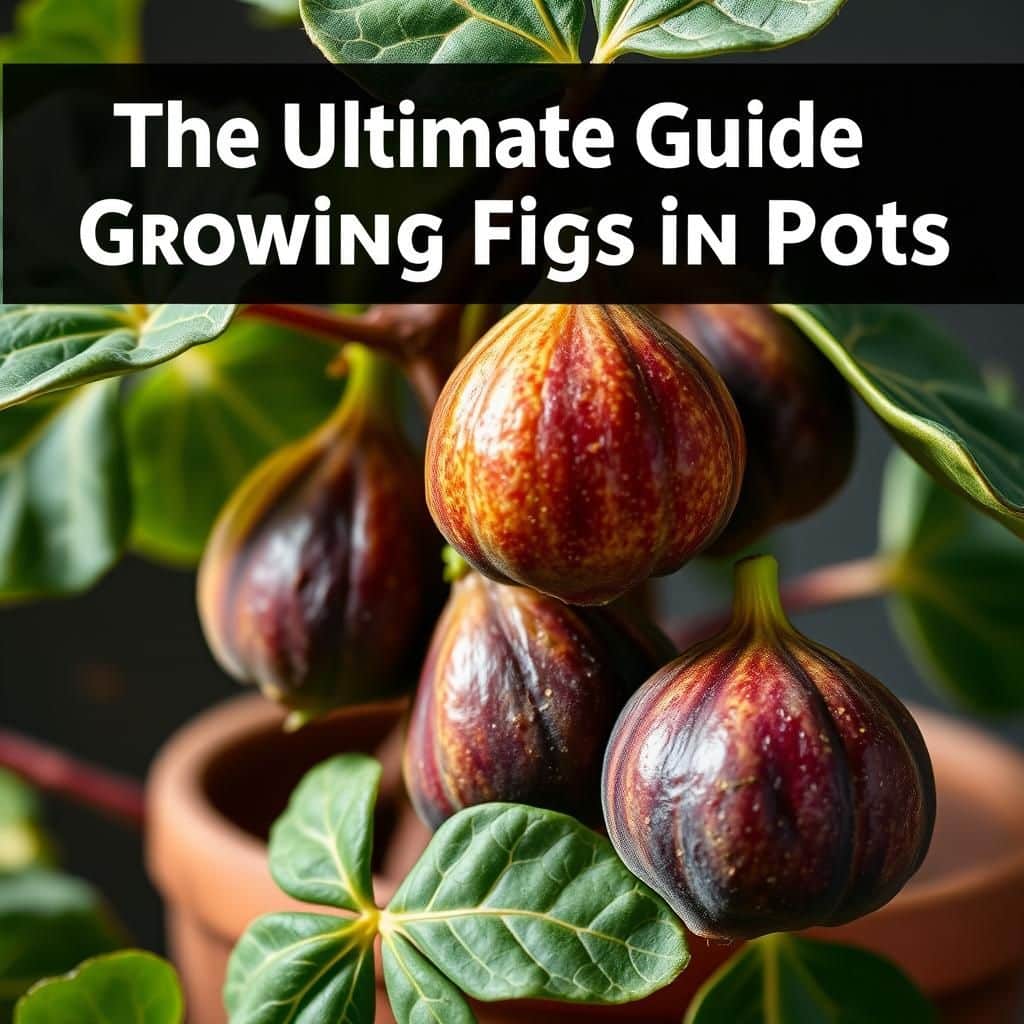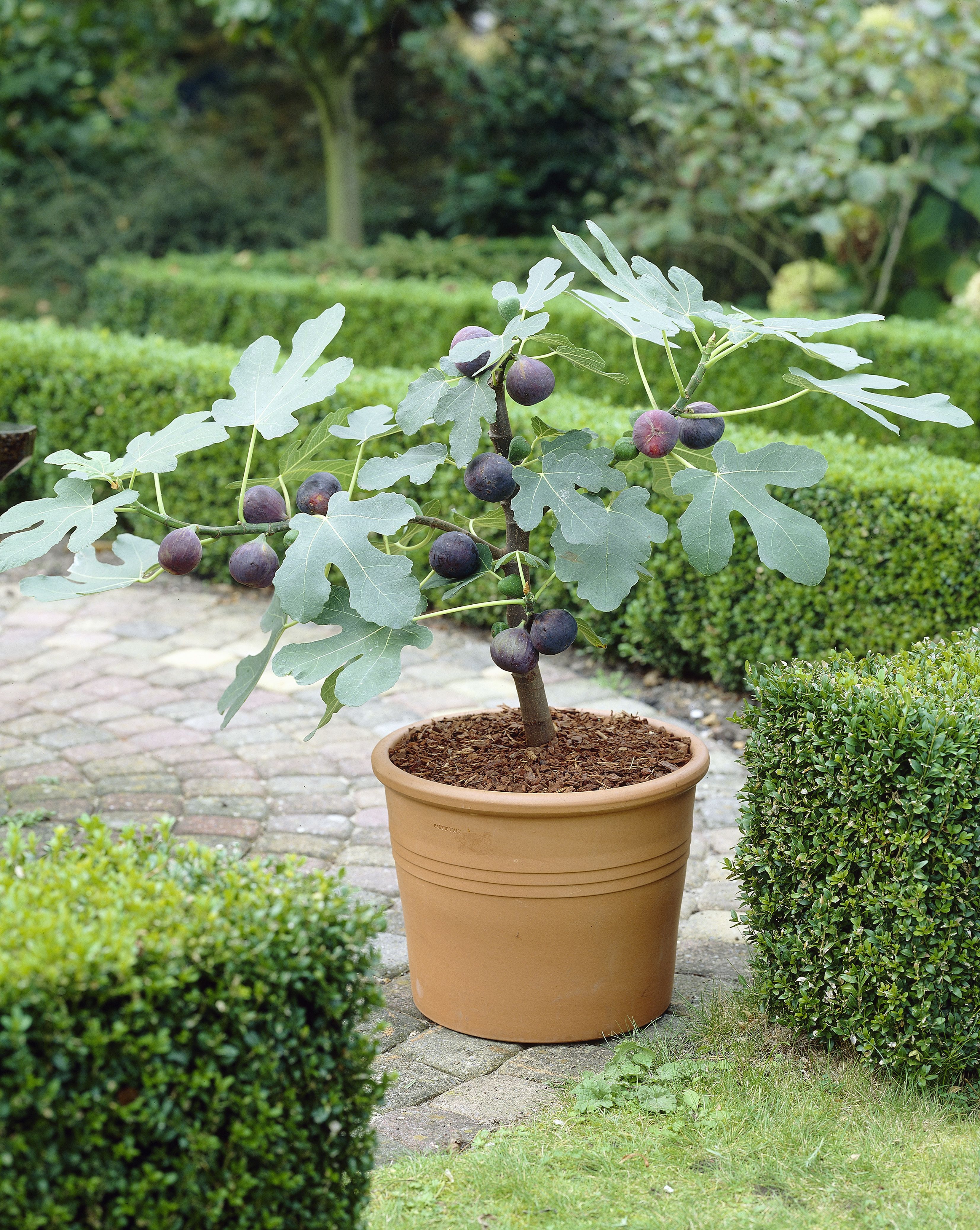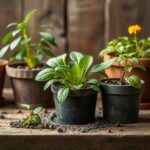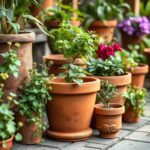The Ultimate Guide to Growing Figs in Pots Australia: Tips and Tricks for Success

Growing figs in pots can be a rewarding endeavor, especially for gardening enthusiasts in Australia. With their lush foliage and sweet fruit, fig trees are a delightful addition to any space, even if you have limited room. This ultimate guide will provide you with essential tips and tricks for successfully cultivating figs in pots, ensuring you can enjoy homegrown fruit right from your balcony or patio. From selecting the right pot and soil to understanding watering and fertilization needs, this article will equip you with the knowledge to nurture your fig trees and optimize their growth for a bountiful harvest.
Growing Figs in Pots in Australia
Growing figs in pots in Australia offers a fantastic opportunity for both novice and experienced gardeners to cultivate these delicious fruits in a manageable space. With Australia's varied climate, many regions can support fig cultivation, provided you choose the right variety and container. Figs thrive in well-draining potting mix, and pots should ideally be at least 30 centimeters in diameter to accommodate the root system. During the warmer months, place your pots in a sunny location, as figs require full sun for optimal growth. Regular watering is essential, but be careful not to overwater, as figs can be susceptible to root rot. Additionally, fertilization during the growing season can enhance fruit production and overall plant health.
Choosing the Right Fig Variety
When selecting a fig variety for pot cultivation in Australia, it's beneficial to choose options that are well-suited to the local climate. Varieties like the Brown Turkey and Kadota figs are popular choices due to their adaptability and resistance to common pests and diseases. Dwarf varieties can also be an excellent choice, as they are explicitly bred to thrive in smaller spaces, allowing for easier management even in confined areas. Understanding your climate zone will also help in choosing the right fig, as some varieties perform better in cooler regions while others prefer warmer conditions.
Potting and Soil Requirements
Using the correct potting mix is crucial for growing figs successfully in pots. A well-draining premium potting mix is recommended, often combined with perlite or coarse sand to improve aeration and drainage. Ensure that your pot has ample drainage holes to prevent water from accumulating at the bottom, which could lead to root rot. The pot should also be sturdy enough to support the plant's growth and heavy fruit load. It's advisable to repot figs every few years to refresh the soil and provide more space for their developing roots.
Watering Techniques
Proper watering techniques play a vital role in developing healthy fig plants. Figs prefer consistently moist, but not soggy, soil, so it’s essential to strike a balance in your watering schedule. Depending on the climate and season, you should check the soil's moisture level regularly. During peak summer months, pots may require watering every two to three days, while in cooler seasons, watering can be reduced to once a week. A good practice is to water deeply, allowing the water to reach the root zone, which promotes more robust growth.
Fertilization for Healthy Growth
Fertilizing your potted figs is essential for encouraging vigorous growth and fruit production. Organic fertilizers, such as compost or well-rotted manure, can provide the necessary nutrients without overwhelming the plant. Fertilization should begin in early spring, just as new growth appears, and continue through the growing season, following the manufacturer's instructions for dosage. It's important to avoid over-fertilizing, as too much nitrogen can lead to excessive leaf growth at the expense of fruiting.
Pest and Disease Management
Managing pests and diseases effectively is crucial for ensuring the health of your potted figs. Common pests that may affect fig trees include aphids, spider mites, and whiteflies. Regularly inspecting your plants and keeping them clean can help prevent infestations. If pests are detected, natural insecticides, such as neem oil, can be effective. Additionally, watch for signs of fungal diseases, such as powdery mildew, and ensure good air circulation around your fig plants to minimize humidity, which fosters disease development.
| Aspect | Details |
|---|---|
| Variety | Brown Turkey, Kadota, Dwarf varieties |
| Pot Size | Minimum 30 cm diameter |
| Soil Type | Well-draining potting mix |
| Watering Frequency | Every 2-3 days in summer |
| Fertilization | Use organic fertilizers; start in spring |
Do figs do well in pots?

Yes, figs can thrive in pots, making them an excellent choice for container gardening. Growing fig trees in pots allows for flexibility in placement and facilitates better control over their growing conditions. Here are some key points to consider when growing figs in pots:
Choosing the Right Pot
Selecting the appropriate pot is crucial for the successful growth of a fig tree. A pot that is too small will restrict root growth and hinder the plant's overall health.
- Size: Choose a pot that is at least 18 inches in diameter and 18 inches deep.
- Material: Opt for pots made of clay, ceramic, or durable plastic that can withstand the outdoor elements.
- Drainage: Ensure the pot has proper drainage holes to prevent waterlogging and root rot.
Soil Requirements
Figs need well-draining soil that retains some moisture yet allows excess water to escape. The right soil mixture can promote healthy growth and fruit production.
- Potting Mix: Use a high-quality potting mix that includes organic materials.
- pH Level: Aim for a soil pH between 6.0 to 7.0 for optimal nutrient absorption.
- Additives: Incorporate perlite or sand for improved drainage and aeration.
Watering Practices
Proper watering is essential to keep potted fig trees healthy. The right amount of water can significantly impact the growth and fruiting of the fig tree.
- Frequency: Water when the top inch of the soil feels dry; figs prefer to be on the drier side.
- Drainage: Ensure any excess water can drain away to prevent soggy roots.
- Seasonal Changes: Adjust watering frequency according to seasonal changes; they require less water in winter.
Sunlight Requirements
Figs require a significant amount of sunlight to produce fruit and grow robustly. Placing the pot in the right location can enhance growth.
- Full Sun: Position pots where they receive at least 6-8 hours of direct sunlight daily.
- Heat Tolerance: Figs can withstand heat well, but be cautious of extreme temperature fluctuations.
- Protection: Provide some shade during the hottest parts of the day in exceedingly hot climates.
Fertilizing Potted Figs
Regular fertilization can promote better growth and fruiting for fig trees grown in pots. Choosing the right fertilizer and application schedule is key.
See also:
- Type of Fertilizer: Use a balanced, slow-release fertilizer with equal parts nitrogen, phosphorus, and potassium.
- Application Schedule: Fertilize during the growing season, typically spring and summer.
- Organic Options: Consider organic fertilizers such as compost or well-rotted manure for nutrient benefits.
How long does it take for a potted fig tree to bear fruit?

For a potted fig tree to bear fruit, it typically takes about 2 to 3 years after planting, although this can vary significantly depending on several factors such as the specific fig variety, growing conditions, and care provided. Young fig trees usually won’t produce fruit during their first year. Proper care, including appropriate watering, fertilizing, and exposure to sunlight, can help expedite fruit production.
Factors Affecting Time to Fruit
The timeline for a potted fig tree to mature and produce fruit can be influenced by various factors:
- Variety of Fig: Certain fig varieties mature faster than others.
- Growing Conditions: Light, temperature, and soil quality can significantly impact growth rates.
- Tree Age: Younger trees will take longer to bear fruit compared to more mature specimens.
Optimal Growing Conditions
To encourage faster fruit production, it’s crucial to create the right growing environment:
- Sunlight: Figs require full sun, ideally 6-8 hours a day, to thrive.
- Soil Quality: Well-draining soil is essential; fig trees prefer sandy or loamy soil.
- Watering: Consistent moisture without waterlogging encourages healthy growth and fruit set.
Potted Fig Tree Care
Caring for your potted fig tree can significantly impact its fruit yield:
- Fertilization: Use a balanced fertilizer during the growing season to provide necessary nutrients.
- Pruning: Regular pruning promotes air circulation and encourages fruit development on new wood.
- Pot Size: Ensure the pot is large enough to allow for root growth, as restricted roots can limit fruiting.
Signs of Fruit Development
As your potted fig tree matures, you may notice several indicators of impending fruit production:
- Bud Formation: Look for the development of small buds which can indicate future fig growth.
- Leaf Production: Healthy leaf growth is often linked to fruit development.
- Stem Growth: New stems or branches often indicate that the tree is preparing to bear fruit.
Harvesting and Post-Production Care
Once your fig tree begins to bear fruit, it’s essential to manage harvesting and subsequent care:
- Harvest Timing: Figs should be harvested when they are fully ripe for the best flavor.
- Post-Harvest Care: Reduce watering slightly after harvesting to allow the tree to rest.
- Long-Term Maintenance: Continue regular care practices to ensure ongoing fruit production in future years.
What is the best fertilizer for fig trees in pots?

To ensure healthy growth and abundant fruit production for fig trees grown in pots, choosing the right fertilizer is crucial. The best fertilizer for fig trees in pots typically contains a balance of essential nutrients, particularly nitrogen, phosphorus, and potassium (often referred to as N-P-K). A fertilizer formulated for fruiting plants or a balanced slow-release fertilizer will work well, as these ensure that the plant receives nutrients over an extended period.
Understanding Nutrient Requirements of Fig Trees
Fig trees require a balanced mix of nutrients to thrive. The primary nutrients include:
- Nitrogen (N): Essential for leaf growth and overall plant health.
- Phosphorus (P): Important for root development and flowering.
- Potassium (K): Supports fruit development and enhances disease resistance.
When selecting a fertilizer, look for a formula with a balanced N-P-K ratio, such as 10-10-10 or 5-10-10, which can support the overall growth of the fig tree.
Types of Fertilizers Suitable for Potted Fig Trees
Several types of fertilizers can be used for potted fig trees, each with its benefits:
- Slow-Release Granular Fertilizers: Provide a steady supply of nutrients over time, reducing the risk of over-fertilization.
- Water-Soluble Fertilizers: Easily absorbed by the roots for quick nutrient uptake; suitable for regular feeding schedules.
- Organic Fertilizers: Such as compost or well-rotted manure, enhance soil health and provide essential nutrients naturally.
Each type has its advantages depending on the gardener's preferences and the specific needs of the fig tree.
Application Frequency and Timing
Applying fertilizer at the right time and frequency is critical for the health of pot-grown fig trees:
See also:
- Spring Fertilization: Start fertilizing in early spring as the tree begins to emerge from dormancy.
- Mid-Season Boost: A second application in mid-summer can support fruit development and overall growth.
- Fall Care: Reduce fertilization in late summer to prepare the tree for dormancy.
Monitoring the tree's growth and adjusting the fertilizer schedule as needed can help optimize its health.
Signs of Nutrient Deficiencies
A lack of essential nutrients can manifest in various symptoms in fig trees:
- Pale or Yellowing Leaves: Often indicates a nitrogen deficiency, which can hinder overall growth.
- Stunted Growth: May signify inadequate phosphorus, impacting root and flower development.
- Small or Poor-Quality Fruits: Suggests a potassium deficiency, affecting fruit size and flavor.
Being aware of these signs can help you address nutrient deficiencies promptly to maintain the health of your fig tree.
Best Practices for Fertilizing Fig Trees in Pots
Implementing effective fertilization techniques can optimize the health of fig trees:
- Use the Right Potting Mix: A well-draining potting mix helps prevent nutrient lockout and promotes healthy root development.
- Water Before Fertilizing: Ensuring the soil is moist before application helps prevent root burn and improves nutrient absorption.
- Follow Recommended Dosages: Adhering to the manufacturer's guidelines will prevent over-fertilization and potential damage to the tree.
By following these best practices, you can establish a successful fertilization routine that supports the thriving growth of fig trees in pots.
What not to plant with fig trees in pots?

When considering what not to plant with fig trees in pots, it's essential to understand both the growth habits of fig trees and the compatibility of other plants in shared containers. Fig trees, particularly the common fig (Ficus carica), thrive in conditions that might not be suitable for other plants, which can lead to competition for nutrients and water.
Incompatible Plant Varieties
For optimal health of fig trees, it is crucial to avoid planting them with varieties that can outcompete them or have similar growth requirements. Some incompatible plant varieties include:
- Rhubarb: This plant is known to absorb significant nutrients and may deprive fig trees of essential resources.
- Brassicas: Cabbage, kale, and broccoli typically require more moisture and nutrients, leading to competition.
- Mint: While aromatic herbs are generally beneficial, mint is highly invasive and can overshadow the fig's growth.
Watering and Moisture Needs
Fig trees prefer a specific watering routine, which may not align with the requirements of certain companion plants. Avoid planting species that necessitate higher moisture levels:
- Watercress: Thrives in wet conditions and can create an overly moist environment harmful to fig trees.
- Lotus: Prefers flooded conditions, which would drown fig roots.
- Cattails: Require very wet soil and can disrupt the drainage needed by fig trees.
Soil Nutrient Competition
Fig trees thrive in nutrient-rich soil, and planting them alongside heavy feeders can lead to nutrient depletion:
- Tomatoes: These plants are heavy feeders that can deplete essential nutrients from the soil.
- Corn: Another nutrient-hungry plant that can hinder fig tree development.
- Peppers: They require abundant nutrients and can compete directly with fig trees.
Space and Growth Habits
The physical space needed by fig trees can be adversely affected by other plants' growth habits, especially if they spread out significantly:
- Squash: Vining varieties can overrun space, blocking sunlight and air circulation to the fig tree.
- Beans: Climbing plants may draw resources upwards, leaving the fig tree deprived.
- Chard: Can spread wide, competing for essential ground space and nutrients.
Potential Pest Attraction
Certain companion plants can attract pests that may harm fig trees. It's wise to avoid those that are known to harbor pests:
- Asters: Attracts aphids, which can infest fig trees.
- Rosemary: While often thought to deter pests, it can attract spider mites detrimental to fig growth.
- Crucifers (like kale): These can attract pests like the cabbage moth, which could also affect nearby fig trees.
Questions from Our Readers
How do I choose the right pot for growing figs in Australia?
When selecting a pot for growing figs, it's important to choose one that has good drainage holes, as figs do not tolerate waterlogged soil. A pot with a diameter of at least 30 to 40 cm is recommended to provide enough space for the roots to grow. Additionally, using a lightweight potting mix that retains some moisture while allowing excess water to escape will help your fig plants thrive.
What type of fig varieties are suitable for pot cultivation in Australia?
Several fig varieties are well-suited for pot cultivation in Australia, including Brown Turkey, Kadota, and Celeste. These varieties are known for their adaptability to container growth and can flourish in Australia's climate. When selecting a variety, consider your local climate and the amount of sunlight the pot will receive.
See also:
How often should I water my fig trees in pots?
Fig trees in pots typically require regular watering, especially during the hot Australian summer. It's crucial to keep the soil moist but not soggy, so a good rule of thumb is to water when the top 2-3 cm of soil feels dry. Always ensure that excess water can drain freely from the pot to prevent root rot.
What fertilization should I use for potted fig trees?
For optimal growth, potted fig trees benefit from a balanced fertilizer applied during the growing season, typically spring and summer. A good option is a slow-release fertilizer that contains equal parts of nitrogen, phosphorus, and potassium. Additionally, consider supplementing with organic matter, such as compost, to enrich the soil and provide essential nutrients.

If you want to read more articles like The Ultimate Guide to Growing Figs in Pots Australia: Tips and Tricks for Success, we recommend you check out our Pots category.
Leave a Reply
Related Articles